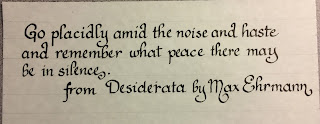Earlier this month, I rather boldly sent a form to
the State Fair indicating that I would be entering one item in the “Zentangle(R)
Inspired Art (ZIA)” category and one item in the “Cards—Holiday and special
occasion” category. It was bold because I had only partially worked out a ZIA
entry (a little paper box with ZIA decoration) and had no plan for the card at
all.
The entries being due by Oct 6, I
finished the box and have been frantically trying to produce a suitable card.
In the process, I have rediscovered how much I enjoy dip pen calligraphy—and in
fact, dip pens in general.
 |
| The box is about a 2-inch cube. |
I learned calligraphy from a book. I think I was
around twelve at the time. The book in question was probably the Speedball
handbook, since I’ve had a copy for as long as I can remember, though I suspect
I took out quite a few books from the library as well. (Do you remember the
days when the library was the main source of interesting information, before
the internet came to be? No?)
There’s just something lovely about the combination
of good words and good shapes. I love to watch the sentence form under my pen,
sometimes with added flourishes and decorations. There are so many alphabets to
choose from, too, each with its own flavor. (“Atmosphere”? “Ambience”?
“Associations,” perhaps, is the better word.)
There are blackletter styles that have a formal,
medieval look to them. There are less formal yet still dressy Italic styles.
Uncials have that Celtic look, and various Copperplate-style scripts bring to
mind (to me, at least) old-fashioned correspondence as well as a certain style
of diploma or a tea party invitation.
When I was in high school (and beyond), I enjoyed
writing out my favorite quotations from books and songs, to stick up on my
wall. (Probably with that blue putty-like stuff. Don’t leave that stuff on your
wall for long, or the white putty-like stuff, either.) I think I should do some
more of those and put them on the pantry door, which has been bare of
quotations for too long. The current idea is to come up with quotes from the
Dresden Files, but since I haven’t read them for a while, I’m going to have to
pick them up again or get someone else to point them out.
 |
| Not Dresden Files, but also pleasing. |
Meanwhile, I have a general plan for the card and
some test versions that make use of the scrolls I was messing around with earlier in the year. Even if my entry is a bit rushed, it’s been worth it
to be reminded of how much I like doing this. Maybe I’ll even make a basic card
that I can send out for birthdays. (I’m already several months behind on those.)
Till next post.
 |
| Working on the elements, short on drawings. |



